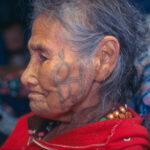Prison tattoos are a language unto themselves, especially within the confines of correctional facilities. For those working in jails and prisons, understanding these symbols can be crucial for maintaining safety and gaining insight into inmate affiliations and backgrounds. Among the myriad of prison tattoos, gang-related ink carries significant weight, and the Latin Kings Tattoo is a prime example of a symbol rich with meaning and history.
This article delves into the world of prison tattoos, focusing specifically on the Latin Kings tattoo and its significance. We will also explore other common prison tattoos, providing a comprehensive guide to help you understand the silent stories etched onto inmates’ skin.
1. 1488
The numerical tattoo “1488” is a clear indicator of white supremacist or Nazi affiliations within prison walls. Both “14” and “88” can be used independently, sometimes leading to misinterpretations.
The number “14” represents the “14 Words,” a well-known quote by white supremacist leader David Lane: “We must secure the existence of our people and a future for White Children.” The number “88” is code for “Heil Hitler.” “H” is the eighth letter of the alphabet, making “88” a numerical abbreviation for “HH.” These tattoos can appear anywhere on the body.
2. The Cobweb
A cobweb tattoo typically symbolizes a long prison sentence. The imagery of a spiderweb trapping prey reflects the feeling of being trapped behind bars for an extended period. The most common placement for this tattoo is the elbow, suggesting the inmate has been “sitting around” for so long that a spider built a web there. It can also be found on the neck.
Be aware that a multi-colored cobweb is unlikely to be a genuine prison tattoo, as colored ink is a rare commodity for tattoo artists within correctional facilities.
3. Teardrop
The teardrop tattoo is one of the most universally recognized prison tattoos, though its precise meaning can vary depending on geographic location and context. In some regions, it signifies a long prison sentence, while in others, it indicates that the wearer has committed murder.
An outlined teardrop can symbolize an attempted murder. It might also represent the murder of a friend, with the wearer seeking revenge. While popularized in mainstream culture by rappers and celebrities, the teardrop remains a significant symbol within prisons. Inmates new to prison sporting a teardrop tattoo without justification may quickly find themselves in conflict.
4. Five-Point Crown: Symbol of the Latin Kings Tattoo
The five-point crown is the unmistakable symbol of the Latin Kings, one of the largest and most established Hispanic gangs in the United States, originating in Chicago. This Latin Kings tattoo is often accompanied by the letters ALKN, an acronym for Almighty Latin Kings Nation. The five points of the crown are a tribute to the People Nation gang affiliation, represented by the number five.
The Latin Kings have a substantial presence both inside and outside of prison, with roots tracing back to the 1940s. The Latin Kings tattoo, beyond the basic crown, can incorporate further hidden meanings in details such as the colors of the jewels within the crown points. Understanding the Latin Kings tattoo is crucial for recognizing gang affiliation and navigating the complex social dynamics within correctional settings. This symbol represents not only gang membership but also a deep-rooted history and structured organization.
5. Three Dots
The three dots tattoo is a prevalent prison tattoo representing “mi vida loca,” Spanish for “my crazy life.” It is not specifically associated with any single gang but rather with the general gang lifestyle itself. Common locations for this tattoo are the hands or around the eyes.
While primarily known for its gang association, the three dots can also hold religious significance, representing the Holy Trinity in Christianity. This tattoo is often created using the rudimentary “stick-and-poke” method due to limited resources in prison.
6. Five Dots
Distinct from the three dots tattoo, five dots represent time served in prison. Also known as a quincunx, the tattoo features four dots on the corners and one in the center. The outer four dots symbolize the four walls of a prison cell, with the central dot representing the prisoner inside.
This tattoo is recognized internationally among both American and European inmates. It is typically placed on the hand, between the thumb and forefinger. However, five dots in other locations can carry different meanings, including an association with the People Nation gang, highlighting the importance of context when interpreting prison tattoos.
7. The Clock with No Hands
The clock with no hands is a fairly straightforward representation of “doing time,” specifically a long prison sentence. Inmates serving extended sentences might have this tattoo placed on their wrist, complete with watch straps, mimicking a real wristwatch.
The clock face design can vary, from wall clocks to grandfather clocks. While not all clock tattoos are prison-related, the absence of hands is generally the key indicator of its prison symbolism.
8. Aryan Brotherhood
The Aryan Brotherhood, a notorious prison gang, utilizes a range of tattoos for identification. These include “AB” lettering and Nazi symbols such as the swastika and SS lightning bolts. Despite comprising only a small percentage of the inmate population (around 1%), the Aryan Brotherhood is responsible for a disproportionately high percentage of murders within U.S. prisons (estimated at 20%). Recognizing these tattoos is therefore critically important for safety.
The Aryan Brotherhood is also sometimes referred to by code names like “Alice Baker,” “the One-Two,” or “The Brand.”
9. Norteño
Norteño tattoos are associated with the Nuestra Familia gang, a network of Hispanic gangs originating in Northern California. Common Norteño tattoos include the word “Norteño” itself, “Nuestra Familia,” a sombrero symbol, the letter “N,” or the number 14, representing the 14th letter of the alphabet (“N”).
The Norteños are rivals of the Sureños, Hispanic gangs from Southern California. Delano, California, is considered the unofficial dividing line between these two groups. Norteños identify with red bandanas and are primarily involved in smuggling and distributing drugs such as cocaine, heroin, and methamphetamine.
10. La Eme
“La Eme,” or simply “M,” is the symbol of the Mexican Mafia, one of the largest and most ruthless prison gangs in the United States. They are allied with the Aryan Brotherhood and share a common enemy in Nuestra Familia.
Interestingly, La Eme originated not in Mexico, but among Mexican-Americans incarcerated in American prisons. La Eme is a Sureño gang, belonging to the larger affiliation of Hispanic gangs in Southern California.
11. MS 13
MS 13, sometimes seen as just MS or 13, is the symbol of the Mara Salvatrucha gang, which originated in El Salvador. These tattoos can appear anywhere on the body but are frequently found in highly visible places like the face, hands, or neck, reflecting the gang’s bold and intimidating image.
Mara Salvatrucha was founded in the Los Angeles area by immigrants from El Salvador. MS-13 has since expanded, with chapters across the U.S. and even into Canada. Their criminal activities range from drug trafficking to child prostitution.
12. Playing Cards
Playing cards or card suits generally indicate an inmate who enjoys gambling. This can refer to gambling both inside and outside of prison, or more broadly, a person who views life as a gamble.
Playing card tattoos are particularly significant in Russian prisons, where each suit holds specific meanings. A spade represents a thief, clubs symbolize criminals in general. Diamond tattoos are reserved for stool pigeons and informants – if an inmate bears a diamond suit, it was likely forcibly applied. Hearts imply the wearer is seeking a romantic partner in prison, which may also be a forced tattoo.
13. EWMN
The letters EWMN stand for “Evil, Wicked, Mean, Nasty.” This tattoo, not associated with any particular gang, simply represents the general attitude of some prison inmates.
Typically found on the knuckles, EWMN tattoos gained popularity after Robert Mitchum’s portrayal of a sociopathic preacher in the 1955 film “The Night of the Hunter.” His character had “love” and “hate” tattooed on his knuckles, inspiring variations like “Rock/Roll” and “Stay/Down.”
14. Cross on the Chest
Especially prevalent in Russian prisons, a cross tattooed on the chest symbolizes a “Prince of Thieves.” This is the highest rank a Russian convict can achieve and is typically worn by high-ranking members of organized crime.
Russian prisons have a rich and complex tradition of prison tattoos, each with unique and intricate meanings. Other examples include bells, symbolizing freedom, and a tiger on the chest, representing aggression towards the police.
15. A.C.A.B.
The acronym A.C.A.B. is commonly found on British prisoners and stands for “All Cops Are Bastards.”
While some jokingly claim A.C.A.B. means “Always Carry A Bible,” this is widely considered a regretful reinterpretation. Often found on the knuckles, this tattoo symbolizes a willingness to go to prison for one’s crew or gang, demonstrating loyalty and defiance towards law enforcement.
Understanding prison tattoos, including the Latin Kings tattoo, is a valuable tool for anyone working within the correctional system or seeking to understand the intricacies of prison culture. These symbols offer a glimpse into the lives, affiliations, and beliefs of those behind bars, aiding in communication, safety, and a deeper comprehension of this unique subculture.

